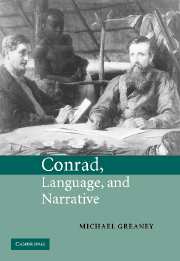Book contents
- Frontmatter
- Contents
- Acknowledgements
- Introduction
- PART I SPEECH COMMUNITIES
- 1 ‘The realm of living speech’: Conrad and oral community
- 2 ‘Murder by language’: ‘Falk’ and Victory
- 3 ‘Drawing-room voices’: language and space in The Arrow of Gold
- PART II MARLOW
- PART III POLITICAL COMMUNITIES
- Conclusion
- Notes
- Bibliography
- Index
3 - ‘Drawing-room voices’: language and space in The Arrow of Gold
Published online by Cambridge University Press: 22 September 2009
- Frontmatter
- Contents
- Acknowledgements
- Introduction
- PART I SPEECH COMMUNITIES
- 1 ‘The realm of living speech’: Conrad and oral community
- 2 ‘Murder by language’: ‘Falk’ and Victory
- 3 ‘Drawing-room voices’: language and space in The Arrow of Gold
- PART II MARLOW
- PART III POLITICAL COMMUNITIES
- Conclusion
- Notes
- Bibliography
- Index
Summary
The Arrow of Gold (1919) belongs with The Rover (1923) and the unfinished Suspense (1925) as part of the ‘trilogy’ of Mediterranean adventure stories written during the final years of Conrad's literary career. None of these novels enjoys a sparkling critical reputation, but The Arrow of Gold has been singled out by no less an authority than Zdzislaw Najder as ‘Conrad's weakest novel’. As Conrad's best biographer, Najder is better qualified than anyone to assess whether the supposedly autobiographical elements of this novel – the Carlist gun-running, the passionate love affair, the duel – have any real basis in the facts of Józef Korzeniowski's life; but his verdict on the artistic qualities of The Arrow of Gold is too peremptory. Recent critics, including Robert Hampson, Susan Jones, and Andrew Michael Roberts, have rediscovered The Arrow of Gold as fiction rather than spurious autobiography; they have focused usefully on its subversive treatment of generic conventions, its exploration of gendered identities, and its representations of visuality and the male gaze. The novel has emerged in recent years as a strange hybrid of the romantic adventure tale and the modernist Künstlerroman, an aesthetically self-conscious text whose rough-and-ready seafaring hero rubs shoulders with Marseilles bohemia in a landscape crowded with sculptures, painting, curios, and all the paraphernalia of fine art.
Though Conrad's readers have begun to take this novel seriously as a modernist text, relatively little has been said of its linguistic self-consciousness.
- Type
- Chapter
- Information
- Conrad, Language, and Narrative , pp. 44 - 54Publisher: Cambridge University PressPrint publication year: 2001



